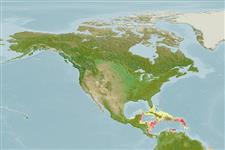Common names from other countries
>
Perciformes/Scorpaenoidei (Scorpionfishes) >
Scorpaenidae (Scorpionfishes or rockfishes) > Scorpaeninae
Etymology: Scorpaenodes: Latin, scorpaena = a kind of fish, 1706 + Greek oides = similar to (Ref. 45335); barrybrowni: Named for Barry Brown, substation Curaçao and free-lance photographer (www.coralreefphotos.com)..
Environment: milieu / climate zone / depth range / distribution range
Écologie
marin récifal; profondeur 95 - 160 m (Ref. 109716). Deep-water
Distribution
Pays | Zones FAO | Écosystèmes | Occurrences | Point map | Introductions | Faunafri
Caribbean: Curaçao, Bonaire and Dominica.
Taille / Poids / Âge
Maturity: Lm ? range ? - ? cm
Max length : 4.7 cm SL mâle / non sexé; (Ref. 109716)
Description synthétique
Clés d'identification | Morphologie | Morphométrie
Épines dorsales (Total) : 13; Rayons mous dorsaux (Total) : 8; Épines anales: 3; Rayons mous anaux: 5; Vertèbres: 24. This species is distinguished by the following set of characters: D soft rays 8; pectoral-fin rays 16-17, rays 11-12 (from uppermost ray) are noticeably longer than rest in smallest four type specimens; caudal-fin rays 25-27; vertebrae 8 precaudal + 16 caudal = 24; spines on suborbital ridge 4 (rarely 5); no secondary suborbital ridge spines; 2 prominent round to oblong pores in suborbital sensory canal immediately ventral to suborbital ridge; absence of coronal, interorbital, upper post temporal and postorbital spines; incomplete lateral line, 8-10 pored scales extending from behind supracleithral spine to mid body; cirri associated with
nasal, supraocular, and parietal spines and present on posteroventral projection of lacrimal
and upper left quadrant of the orbit; no cirri associated with postocular, tympanic,
supracleithral, and lower posttemporal spines; relatively elongate body, its depth at origin
of dorsal fin 30-32% SL, depth at caudal peduncle 9-10% SL; when alive, colour bright
orange-red with several reddish-brown bars on posterior portion of trunk, the pectoral fin
with vivid yellow spots interspersed with bright orange-red spots (Ref. 109716).
Collected on rocky substrata on a vertical rock wall (Ref. 109716).
Life cycle and mating behavior
Maturities | Reproduction | Spawnings | Egg(s) | Fecundities | Larves
Baldwin, C.C., D.E. Pitassy and D.R. Robertson, 2016. A new deep-reef scorpionfish (Teleostei: Scorpaenidae, Scorpaenodes) from the southern Caribbean with comments on depth distributios and relationships of western Atlantic members of the genus. ZooKeys 606:141-158. (Ref. 109716)
Statut dans la liste rouge de l'IUCN (Ref. 130435)
CITES (Ref. 128078)
Not Evaluated
Menace pour l'homme
Harmless
Utilisations par l'homme
Outils
Articles particuliers
Télécharger en XML
Sources Internet
Estimates based on models
Phylogenetic diversity index (Ref.
82804): PD
50 = 0.5000 [Uniqueness, from 0.5 = low to 2.0 = high].
Bayesian length-weight: a=0.01259 (0.00606 - 0.02615), b=3.03 (2.86 - 3.20), in cm Total Length, based on LWR estimates for this (Sub)family-body shape (Ref.
93245).
Niveau trophique (Ref.
69278): 3.3 ±0.5 se; based on size and trophs of closest relatives
Résilience (Ref.
120179): Haut, temps minimum de doublement de population inférieur à 15 mois (Preliminary K or Fecundity.).
Fishing Vulnerability (Ref.
59153): Low vulnerability (10 of 100).
